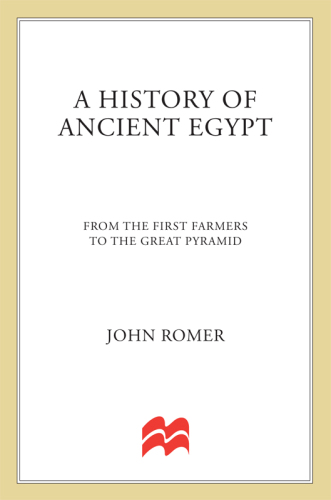
A History of Ancient Egypt
From the First Farmers to the Great Pyramid
کتاب های مرتبط
- اطلاعات
- نقد و بررسی
- دیدگاه کاربران
نقد و بررسی

October 7, 2013
In this thoughtful and meticulous reconsideration of Egyptian ancient- and pre-history, Egyptologist Romer draws directly from archaeological and hieroglyphic evidence in an effort to cast aside Western preconceptions. This, the first of two volumes, begins with a focus on the farmers of Faiyum Lake in 5000 BCE and ends with the building of the Great Pyramid of Giza, tomb of the pharaoh Khufu, in around 2500 BCE. Romer comments on the logical fallacies of other historians, citing physical evidence. He remarks, for instance, that previous interpretations of the Second Dynasty are "uge histories built upon the thinnest evidence." He also cautions that it is "important to recognize the traps that lurk within the very words we use," suggesting that to even name the inhabited region along the Nile "Egypt" is to make an unwarranted assumption. Though careful in building towards his conclusions, the author waxes lyrical in his descriptions of some of the exquisite works of art which form the basis of our understanding of these dwellers by the Nile. An essential read for anyone interested in Egyptian history. Maps and photos.

July 15, 2013
The first volume of a necessarily lengthy history of ancient Egypt from a well-known archaeologist. Romer's (The Great Pyramid: Ancient Egypt Revisited, 2007) explanation of the earliest years of Egyptian civilization is impressive in the amount of information gleaned from a minimum of evidence. He begins 2,500 years before the pyramids as we know them appeared. The first recognizable community of the Neolithic Revolution gathered in Lake Faiyum in 5000 B.C. Though agriculture was in its beginning stages, the people used grain storage bins and moved the herds seasonally for grazing. The author debunks thousands of years of miscategorization of the Egyptian culture based on information reliant on ancient biblical and Pharaonic writings. Many writers only got one view of affairs, ignoring the advancement of the populace, and tended to see development in terms of their own civilization rather than that of the geographic, religious terms of the Nilotic environment. Romer points out that the best indicators of the changing civilization turn out to be its pottery. From the very earliest times, inhabitants made containers for cooking and eating. The changes in the shapes and, especially, in the decoration and glazes of their pots indicate the broadening of their development. Every discovery near the Nile contains some pottery that is accurately dated according to William Petrie's Sequence Dating Chart, a simple classification system developed in the 1890s and corroborated by carbon dating. The Nile River was the driving factor in all aspects of life, from channeling the annual inundation to the riverization that fostered the beginnings of commerce. Fascinating reading with abundant illustrations. Romer's long experience and practical, fresh outlook bring this civilization to life.
COPYRIGHT(2013) Kirkus Reviews, ALL RIGHTS RESERVED.

Starred review from September 1, 2013
During his long career in Egyptology, archaeologist Romer (The Great Pyramid) has excavated in the Valley of the Kings and Karnak, written a dozen books on the subject, and presented critically acclaimed TV documentaries. He is now in the process of reassessing the history of ancient Egypt. In this first of what will be two volumes, he covers from 5000 to 2550 BCE, from Egypt's "beginnings to the establishment of the full panoply of the pharaonic state." This formative period was an afterthought in Alan Gardiner's classic Egypt of the Pharaohs, literally placed at the end of the book. W.B. Emery's Archaic Egypt and Michael A. Hoffman's Egypt Before the Pharaohs offered popularly oriented overviews. Romer challenges the reader to reconsider the development of civilization in the Lower Nile Valley with unbiased eyes and to keep in mind the paucity of archaeological evidence from which the traditional narrative has been derived. He is a proponent of a dynamic evolution of the indigenous culture rather than of change coming to Egypt from external forces. VERDICT Scholarly yet accessible to the nonspecialist, this iconoclastic study will thoroughly engage all Egyptophiles, who will eagerly await the second volume.--Edward K. Werner, St. Lucie Cty. Lib. Syst., Ft. Pierce, FL
Copyright 2013 Library Journal, LLC Used with permission.

























دیدگاه کاربران